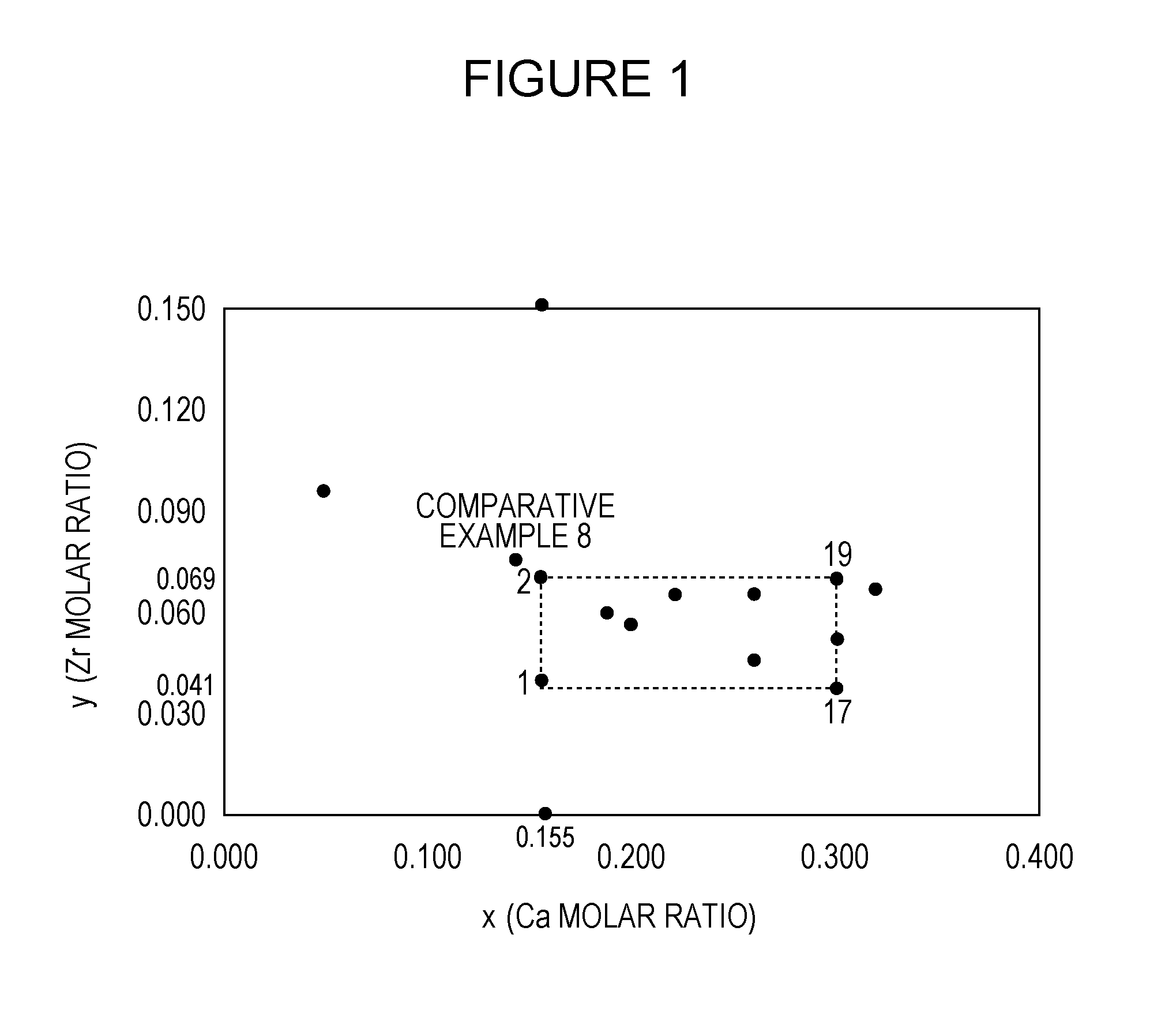Piezoelectric material
a piezoelectric material and material technology, applied in piezoelectric/electrostrictive/magnetostrictive devices, basic electric elements, electrical equipment, etc., can solve the problems of material likely to undergo depolarization when ac voltage is applied, degradation of piezoelectric properties, etc., to achieve excellent piezoelectric constant and mechanical quality factor, and wide operating temperature range
- Summary
- Abstract
- Description
- Claims
- Application Information
AI Technical Summary
Benefits of technology
Problems solved by technology
Method used
Image
Examples
example 1
[0061]Barium titanate having an average particle diameter of 100 nm (BT-01 produced by Sakai Chemical Industry Co., Ltd.), calcium titanate having an average particle diameter of 300 nm (CT-03 produced by Sakai Chemical Industry Co., Ltd.), and calcium zirconate having an average particle diameter of 300 nm (CZ-03 produced by Sakai Chemical Industry Co., Ltd.) were weighed so that the ratio was 84.5:11.4:4.1 on a molar basis. In order to adjust the molar ratio a of Ba and Ca in A sites to Ti and Zr in B sites, 0.014 mol of barium oxalate was added. The resulting mixture was dry-mixed in a ball mill for 24 hours. To the resulting mixture, 0.18 parts by weight of manganese(II) acetate on a manganese metal basis and 3 parts by weight of a PVA binder relative to the mixed powder were caused to adhere to surfaces of the mixed powder by using a spray dryer in order to granulate the mixed powder.
[0062]The granulated powder was charged in a mold and pressed under 200 MPa of forming pressure...
examples 2 to 21
[0068]Barium titanate having an average particle diameter of 100 nm (BT-01 produced by Sakai Chemical Industry Co., Ltd.), calcium titanate having an average particle diameter of 300 nm (CT-03 produced by Sakai Chemical Industry Co., Ltd.), and calcium zirconate having an average particle diameter of 300 nm (CZ-03 produced by Sakai Chemical Industry Co., Ltd.) were weighed so that the ratio on a molar basis was as shown in Table 1. In order to adjust the molar ratio a of Ba and Ca in A sites to Ti and Zr in B sites, barium oxalate in an amount indicated in Table 1 was added. These powders were dry-mixed in a ball mill for 24 hours. In Example 16, a total of 1.0 part by weight of Si and Cu on an oxide basis were added as auxiliary components. To the resulting mixture, manganese(II) acetate in an amount on a manganese metal basis shown in Table 1 and 3 parts by weight of a PVA binder relative to the mixed powder were caused to adhere to surfaces of the mixed powder by using a spray dr...
examples 1 to 21
[0080]Piezoelectric elements were prepared as follows by using ceramics of Examples 1 to 21.
[0081]A gold electrode having a thickness of 400 nm was formed on both sides of the disk-shaped ceramic described above by DC sputtering. A titanium film functioning as an adhesive layer and having a thickness of 30 nm was formed between the electrode and the ceramic. The ceramic with the electrodes was cut into a strip-shaped piezoelectric element 10 mm×2.5 mm×0.5 mm in size.
[0082]The piezoelectric element was placed on a hot plate having a surface adjusted to 60° C. to 100° C. and a 1 kV / mm electric field was applied to the piezoelectric element for 30 minutes to conduct a polarization treatment.
[0083]The static characteristics, i.e., the Curie temperature, the piezoelectric constant d31, and the mechanical quality factor (Qm), of the polarized piezoelectric elements that include piezoelectric materials of Examples and Comparative Examples were evaluated. The results are shown in Table 4. I...
PUM
| Property | Measurement | Unit |
|---|---|---|
| Temperature | aaaaa | aaaaa |
| Temperature | aaaaa | aaaaa |
| Length | aaaaa | aaaaa |
Abstract
Description
Claims
Application Information
 Login to View More
Login to View More - R&D
- Intellectual Property
- Life Sciences
- Materials
- Tech Scout
- Unparalleled Data Quality
- Higher Quality Content
- 60% Fewer Hallucinations
Browse by: Latest US Patents, China's latest patents, Technical Efficacy Thesaurus, Application Domain, Technology Topic, Popular Technical Reports.
© 2025 PatSnap. All rights reserved.Legal|Privacy policy|Modern Slavery Act Transparency Statement|Sitemap|About US| Contact US: help@patsnap.com

